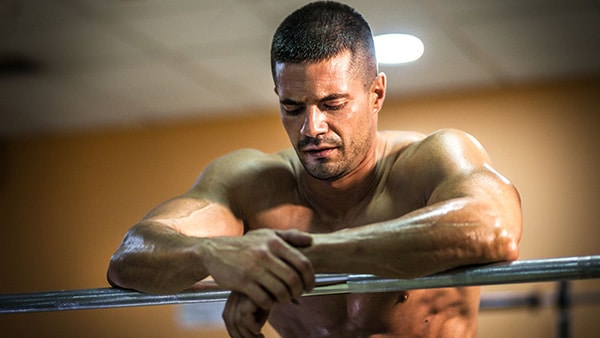Pour prendre du volume, de nombreux pratiquants de musculation et de fitness font le choix de s’entraîner à l’échec musculaire. À l’inverse, d’autres avancent que cette technique d’intensification freine justement l’hypertrophie et accentue le risque de blessures.
Mais alors, qu’en est-il réellement ? Découvrez dans cet article les avantages et les inconvénients de l’entraînement à l’échec, ainsi que mes conseils de coach sportif pour l’inclure dans vos séances de musculation.
S’entraîner jusqu’à l’échec, en bref :
- L’échec musculaire consiste à s’entraîner jusqu’à ne plus pouvoir faire une répétition de plus.
- Cette méthode sollicite intensément le système nerveux, plus encore que les muscles eux-mêmes.
- Le risque de blessure est plus élevé, surtout si la technique se dégrade en fin de série.
- Le volume total d’entraînement reste plus important que d’aller à l’échec.
- L’échec peut être utilisé ponctuellement, surtout sur les exercices d’isolation.
- Privilégier l’échec technique permet de progresser sans se blesser.
Sommaire
Qu’est-ce que l’échec musculaire ?
Définition de l’échec musculaire
Avant d’aller plus loin, répondons à une question posée par de nombreux débutants : c’est quoi l’échec musculaire ?
La technique de l’échec vise à réaliser le plus de répétitions possible sur un exercice, dans le but de favoriser la croissance musculaire. En d’autres termes, vous ne devez plus pouvoir effectuer une seule répétition supplémentaire à l’issue d’une série à l’échec.
S’entraîner jusqu’à l’échec peut se faire de deux manières :
- Avec des charges lourdes, et un faible nombre de répétitions ;
- Avec des charges légères, et un nombre important de répétitions.
L’échec musculaire implique donc un effort intense. Certains athlètes estiment que s’entraîner avec cette méthode est le meilleur moyen pour déclencher l’hypertrophie musculaire et gagner en force.
Mais le fait de ne plus pouvoir réaliser une répétition de plus avec une charge donnée signifie-t-il que vos muscles sont à bout de souffle ? En réalité, cela est plus complexe.
Pour bien comprendre l’échec, il est essentiel de connaître le rôle que joue le système nerveux en musculation.
Le rôle du système nerveux lors de vos entraînements de musculation
Lorsque vous arrivez à l’échec sur des exercices de musculation tels que le squat, les tractions, le curl biceps ou le développé couché, cela ne signifie pas que vos muscles sont exténués.
En réalité, c’est votre système nerveux qui vous empêche de réaliser cette fameuse répétition supplémentaire, et non pas l’incapacité du muscle à se contracter.
Lorsqu’il arrive à un stade d’épuisement, le système nerveux enclenche naturellement un processus de sécurité visant à vous protéger contre les blessures. Il agit comme un fusible qui préserve une installation contre les surcharges électriques.

Cela s’explique par le fait que le système nerveux se fatigue plus rapidement que le groupe musculaire sollicité par le mouvement.
Vous verrez plus loin dans cet article qu’il est important de tenir compte de ce mécanisme pour inclure la méthode de l’échec dans votre programme de musculation.

DÉCOUVREZ TOUS MES PROGRAMMES
Téléchargez mon application MetamorphX et commencez votre transformation physique dès aujourd’hui !
Les avantages et les inconvénients de l’entraînement à l’échec musculaire
Les avantages de cette technique d’intensification
Commençons par les avantages de l’échec musculaire.
Pour cela, il est essentiel de savoir comment les muscles grossissent. Lors d’une séance à la salle de fitness, le fait de soulever de la fonte entraîne l’apparition de lésions au niveau de vos fibres musculaires.
Une fois l’entraînement terminé, ces mêmes fibres endommagées se reconstruisent. Elles deviennent alors plus épaisses et plus résistantes.
C’est ce qui permet de gagner en volume et de prendre de la force après une séance de musculation où les fibres sont sollicitées. Ce phénomène porte le nom d’anabolisme.
À la lecture de ce mécanisme, chaque pratiquant devrait donc avoir intérêt à déchirer ses fibres le plus possible pour optimiser sa congestion. En théorie, la méthode de l’échec semble donc idéale pour devenir musclé, dans la mesure où elle permettrait de solliciter les groupes musculaires de manière optimale.
La technique de l’échec peut aussi vous aider à casser des plateaux si vous êtes dans une phase de stagnation. En poussant vos muscles proches de leurs limites, vous pourrez débloquer votre progression et atteindre votre objectif de développement musculaire.
Les inconvénients de l’échec en musculation
La technique de l’échec est toutefois loin d’être parfaite. Elle présente même plusieurs désavantages.
Vous l’avez compris, cette approche sollicite le système nerveux de manière intensive. Pour récupérer pleinement, ce dernier a besoin d’un temps de repos supérieur à celui des muscles.
Si vous souhaitez utiliser la méthode de l’échec musculaire dans votre plan d’entraînement, vous devrez donc veiller à vous accorder des temps de récupération suffisants entre chaque séance. Cela peut avoir pour conséquence de ralentir votre construction musculaire.
Et si vous ne vous reposez pas assez, vous vous exposerez à un risque plus important de blessure.
La probabilité de vous blesser est également plus élevée du fait des charges utilisées. En effet, soulever lourd peut grandement affecter votre technique d’exécution. Et c’est justement au moment où vous êtes le moins focalisé sur votre mouvement que des douleurs peuvent apparaître.
Aller à l’échec musculaire : que dit la science ?
Plusieurs études se sont intéressées au concept d’échec musculaire, avec des conclusions parfois opposées sur les bienfaits de cette approche.
En 2020, quatre chercheurs (Jozo Grgic de la Victoria University de Melbourne, Brad J. Schoenfeld et John Orazem du Lehman College de New York, et Filip Sabol de l’Université de Zagreb) ont entrepris la réalisation d’une méta-analyse.
Cette méta-analyse fait la synthèse des résultats des 15 études les plus pertinentes sur le sujet de l’échec musculaire, portant sur un total de 394 personnes.
D’après leur conclusion, que ce soit pour construire du muscle ou pour développer la force, il n’y a pas de différences significatives entre l’échec musculaire et les méthodes de musculation classiques.
L’entraînement à l’échec ne serait donc pas le meilleur moyen d’atteindre l’hypertrophie maximale.
Il semble que le volume d’entraînement soit une variable plus importante pour augmenter la force. En ce sens, il serait préférable de garder 1 ou 2 répétitions de réserve avant l’échec.

Alors, faut-il aller à l’échec musculaire ?
Compte tenu de ces avantages et de ces limites, est-il pertinent d’intégrer l’échec dans votre programme de muscu ?
Pour répondre à cette question, prenons l’exemple de deux athlètes de niveau identique et dont l’objectif est de gagner du muscle.
Sur des exercices de base tels que les squats ou le développé couché, le premier va jusqu’à l’échec tandis que le second privilégie le volume. Grâce à ses répétitions de réserve, le second pratiquant de musculation pourra réaliser trois ou quatre séries régulières et donc soulever un volume total supérieur au premier, dont les performances baisseront d’une série sur l’autre.
Pour rappel, le volume est le critère principal pour développer les muscles. Il n’est donc pas conseillé d’aller à l’échec musculaire à chaque série de votre séance.
Pour autant, réaliser des séries à l’échec musculaire peut être bénéfique sur certains exercices d’isolation notamment. Vous pouvez tout à fait intégrer cette méthode à votre programme sur des curls biceps avec haltères ou des extensions triceps à la poulie, par exemple.
Pour progresser régulièrement, il peut aussi être pertinent de mettre en place un entraînement par cycles, en ajoutant quelques séances consacrées à des séries courtes avec des charges lourdes.
Gardez à l’esprit que votre système nerveux aura besoin d’un temps de récupération plus important lors de ces phases. Ainsi, n’hésitez pas à prévoir une semaine de deload pour bien récupérer entre chaque cycle.
De nombreux élèves me demandent mon avis sur l’échec musculaire. Personnellement, je privilégie toujours l’échec technique lors de mes entraînements.
Concrètement, cela consiste à arrêter l’exercice dès que vous sentez que votre technique se dégrade. Cette approche présente trois avantages principaux :
- Elle minimise le risque de blessure ;
- Elle permet d’augmenter la masse musculaire et de progresser ;
- Elle limite le risque de surentraînement.
Conclusion
Le travail à l’échec est une technique très appréciée par les pratiquants en prise de masse. Controversée par la littérature scientifique, elle est particulièrement exigeante pour le système nerveux et demande des temps de repos importants. Utilisée avec parcimonie dans le cadre d’un entraînement par cycle, elle peut alors être bénéfique pour maximiser l’hypertrophie.
FAQ
C’est le moment où vous ne pouvez plus faire une répétition supplémentaire sans tricher ou dégrader votre technique.
Non, cela fatigue trop le système nerveux et augmente le risque de blessure. Il vaut mieux garder 1 ou 2 répétitions de réserve.
Oui, mais utilisé avec modération. Il peut aider à casser une stagnation, surtout sur des exercices d’isolation.
Oui, si mal utilisé. Cela peut entraîner des blessures, surtout avec des charges lourdes ou une mauvaise technique.
L’échec musculaire survient quand les muscles ne peuvent plus bouger la charge. L’échec technique, quand l’exécution devient incorrecte.
Pas forcément. Le volume d’entraînement total est plus important pour l’hypertrophie.






